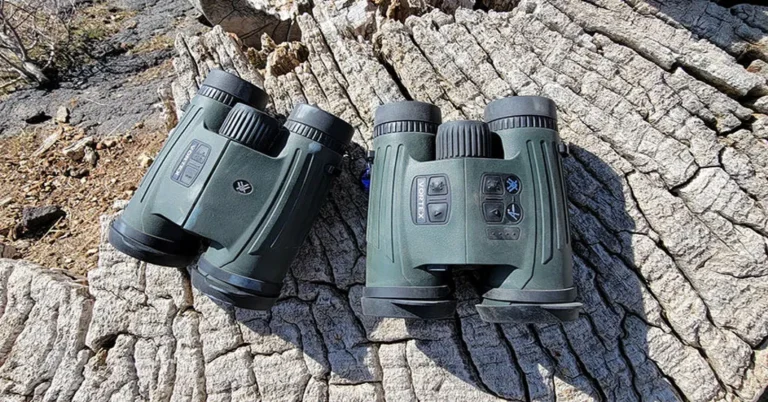The Best Binoculars for Stargazing: The Ultimate Guide 2026
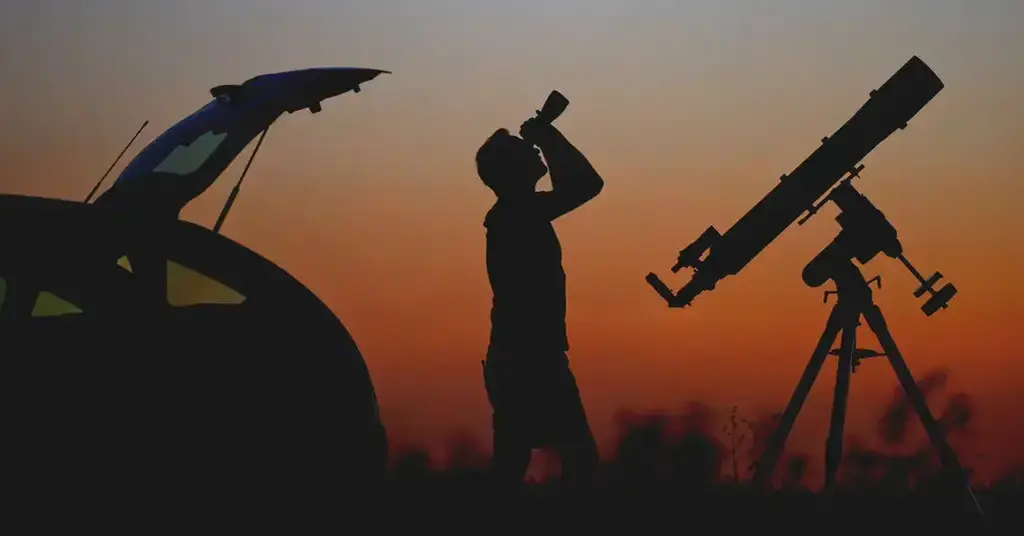
You can use binoculars for a different purpose, including sightings of birds, other wild animals, and stargazing. The perfect pair of binoculars will be easy to hold, comfortable to carry, safe to use in all conditions and offer clear and bright views. Coated lenses help to remove glare and reflections, increasing the efficiency of light transmission and providing sharp images.
Binoculars will be more portable and affordable than telescopes. Making it a good choice for casual stargazing. Those looking to use binoculars for star observation will need to look for large front lenses.
That will absorb more light from distant stars. Along with high magnification to bring celestial objects into focus. Our reviewer tested all the listed binoculars to help you to choose the best binoculars.
If you are looking for portable binoculars that will fit in your pocket, easily check out our other guides on binoculars.
Key Features to Consider
Magnification Power
Magnification tells how much larger an object appears when viewed through the binoculars. Magnification is usually expressed as a number (e.g., 10x, 20x) or a ratio (e.g., 10:1, 20:1). Higher magnification allows you to see finer details but comes at the expense of a narrower field of view (the area you can see at once).
Aperture or Objective Lens Diameter
These terms are interchangeable and refer to the diameter of the front lens of a binocular. The larger the aperture, the more light it gathers, resulting in a brighter and higher-resolution image. The aperture is especially important for low-light scenarios.
Field of View
This characteristic describes the area you can see through the binoculars at a given distance. It is inversely proportional to magnification; a higher magnification lens will have a narrower field of view. Field of view is crucial if you require observing a larger area, such as examining a map or a large area.
Eye Relief
It is a comfortable working distance between your eye and the magnifying lens. It’s the distance at which you can see a clear, full field of view without straining your eye. A longer eye relief allows for more comfortable viewing, especially for people who wear eyeglasses.
Lens Coating
Many magnifying devices come with lenses that have anti-reflective coatings. These coatings minimize glare and reflections, improving image clarity and reducing eye strain, especially during prolonged use. Some coatings may also filter out ultraviolet (UV) light for added protection.
Types of Binoculars
Binoculars come in various types; here is an explanation.
Prism Design:
- Porro Prism: Light takes a zig-zag route in binoculars, resulting in a wider body with offset eyepieces. It is generally more affordable with a wider field of view in some models. This made the binocular bulkier and made it difficult to hold for a long time.
- Roof Prism: Light folds straight through the binoculars, creating a sleeker, more compact design. That makes it portable and easy to handle in any situation.
Size:
- Compact: it is lightweight and highly portable, which makes it ideal for carrying a pocket or bags. However, it comes in smaller magnification and small objective lenses, resulting in poor performance in low-light situations.
- Full-Size: it is large in size and heavier in weight, which makes it less convenient to carry around. However, it usually has higher magnification and wider objective lenses that bend more light in binoculars. And provides clear images.
Top 5 Picks for Stargazing
Explore Scientific G400 15×56 roof prism binoculars.
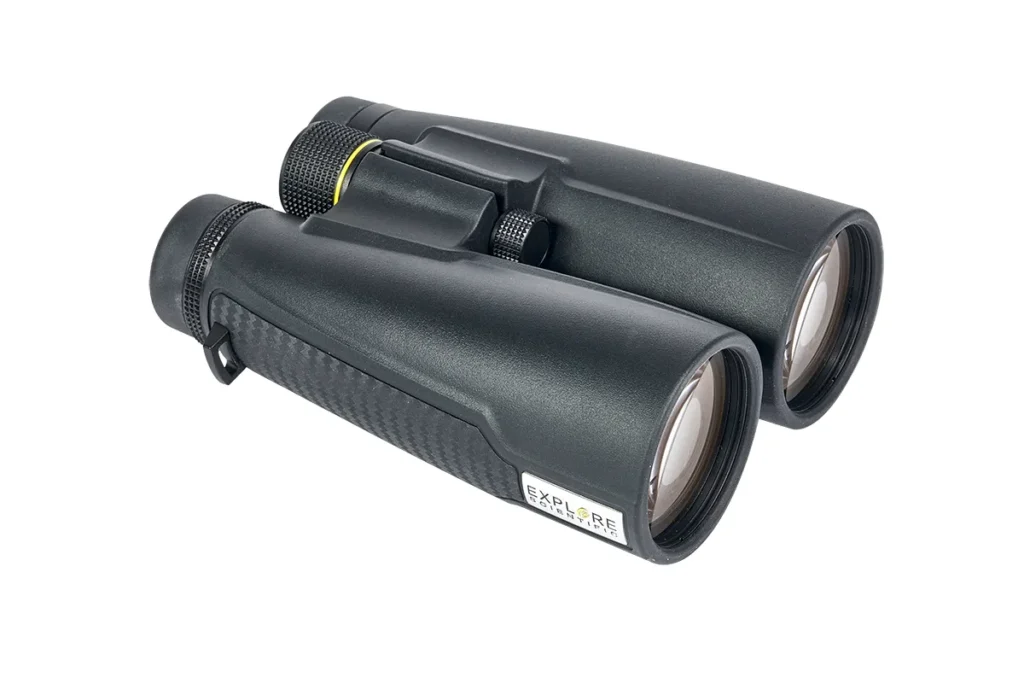
Explore Scientific’s G400 15×56 binoculars are a perfect option for someone who already has a pair of smaller hand-held binoculars, but if you are a hunter, a compact model is suitable for you. The G400 binoculars are the best choice suitable for astronomy and stargazing. During our test, we found it a joy to use.
Stars appear very sharp in the center of the sky and become fuzzy near the edge. We will use it to scan colorful clusters like the Meissa cluster, cluster collider 70 overflowing the 4-degree field of view. The chains of stars appear to form. We can observe three trapezium stars in the texture of the Orion nebula.
Specs
| Optics | Fully multi-coated |
| Aperture | 56mm |
| Magnification | 15x |
| Prisms | Schmidt–Pechan roof, BaK-4 glass, phase-coated |
| Angular field of view | 4° |
| Focusing | Centre focus |
| Eye relief | 16mm |
| Interpupillary distance | 61–70mm |
| Weight | 1.1kg |
BEST FOR:
- Waterproof
- Nitrogen-filled,
- Neck strap,
- Tethered lens caps,
- Fully multi-coated,
- Well-designed case
PROS:
- High Magnification
- Tripod Adaptable
- Waterproof and Nitrogen-filled
- Phase-Coated Optics
CONS;
- Weight
- Limited Field of View
- Price
Canon 12×36 IS III binoculars.
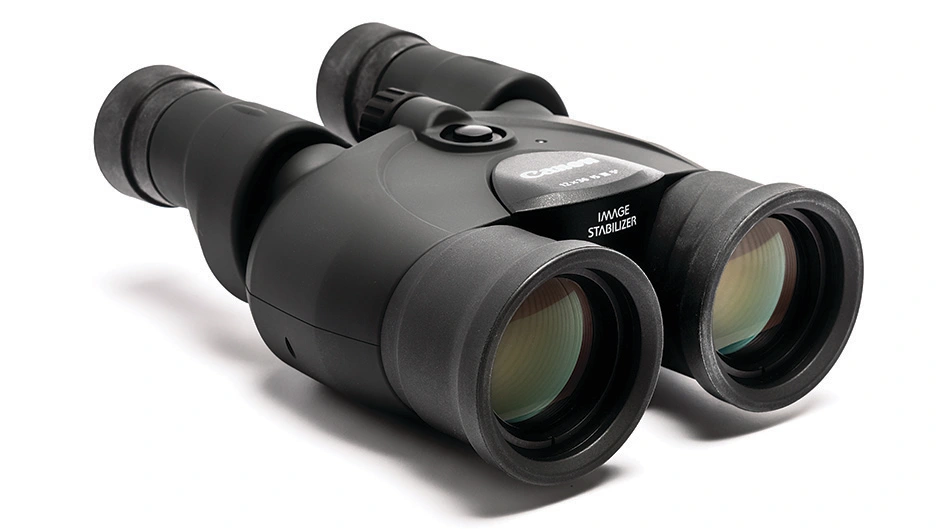
The image stabilization binoculars are perfect binoculars for astronomy and stargazing, and they are designed to hold during use. The Canon 12×36 IS III is a great choice in that category. It comes in a padded case with a neck strap and individual eyepiece caps. Holding the binoculars up to the skylight. We could see that the exit pupils had no cut-offs or grey sections. This tells us the prism type. It is full-sized, and this glass has a beautiful refractive index. We set the binoculars to the moon and Jupiter and found no ghost images. It has excellent control of stray light. We really tried its image stabilization feature. Faint stars became visible, and the image became completely still. It is a very good pair of binoculars, great for observation in the dark sky.
Specs
| Apparent field of view | 55.3° |
| Binocular type | Prism |
| Power | 2 x AAA size batteries |
| Battery life | 25°C, approx 9 hours -10°C, approx 1 hour (using alkaline batteries) (2) |
| Operating humidity range | 90% |
| Operating temperature range | -10°C to 45°C |
| Depth | 70mm |
| Height | 174mm |
| Width | 127mm |
| Weight | 660g |
BEST FEATURES:
- Super Spectra multi-coatings
- Porro Type II prisms
- Objective lens focusing
- Battery-powered
- Good interpupillary distance range.
PROS
- Impressive stabilisation performance
- Lightweight and easy to pack
- Crystal clear viewing
- Excellent image quality
- Good for daytime and nighttime use
- Great for astronomy
- Compact and portable
- Pinpoint stars and good moon detail
CONS
- No objective lens covers
- Have to hold the IS button down
Bresser 10×50 Corvette binoculars
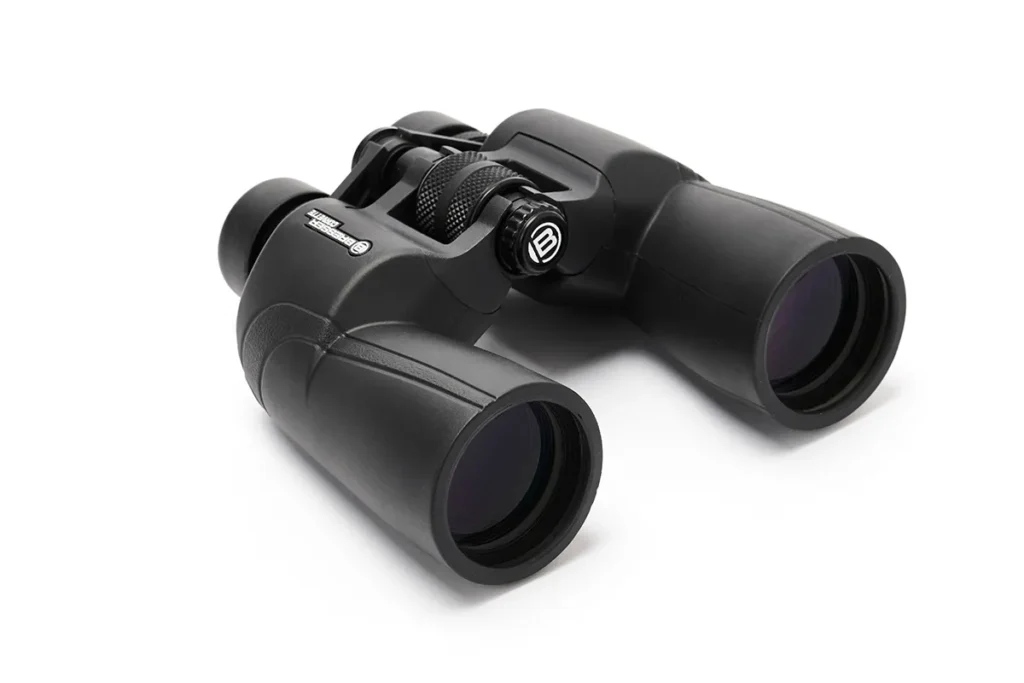
The Bresser 10×50 corvette binoculars come with extras such as a nylon case tethered lens caps for the objective lenses, a 25 cm-wide neck strap, a rain guard for the eyepiece, a microfiber cleaning cloth and an instruction booklet.
These binoculars have a precise focusing system that makes them ideal for astronomy. Indeed, we found stars in the middle of the sky and snapped them into the best focus.
Specs
| Optics | Fully multi-coated |
| Aperture | 50mm |
| Magnification | 10x |
| Prisms | Porro, BaK-4 |
| Angular field of view | 6° |
| Focusing | Centre focus |
| Eye relief | 16mm |
| Interpupillary distance | 57mm-72mm |
| Weight | 940g |
BEST FOR
- Precise focus,
- Tripod-mountable
- Anti-reflective coatings
- Waterproof and inert gas-filled
- Tethered lens caps
PROS:
- Clear view
- Good magnification
- Durable build
CONS;
- Heavy
- Eye strain
Opticron Oregon WA 10×50 binoculars
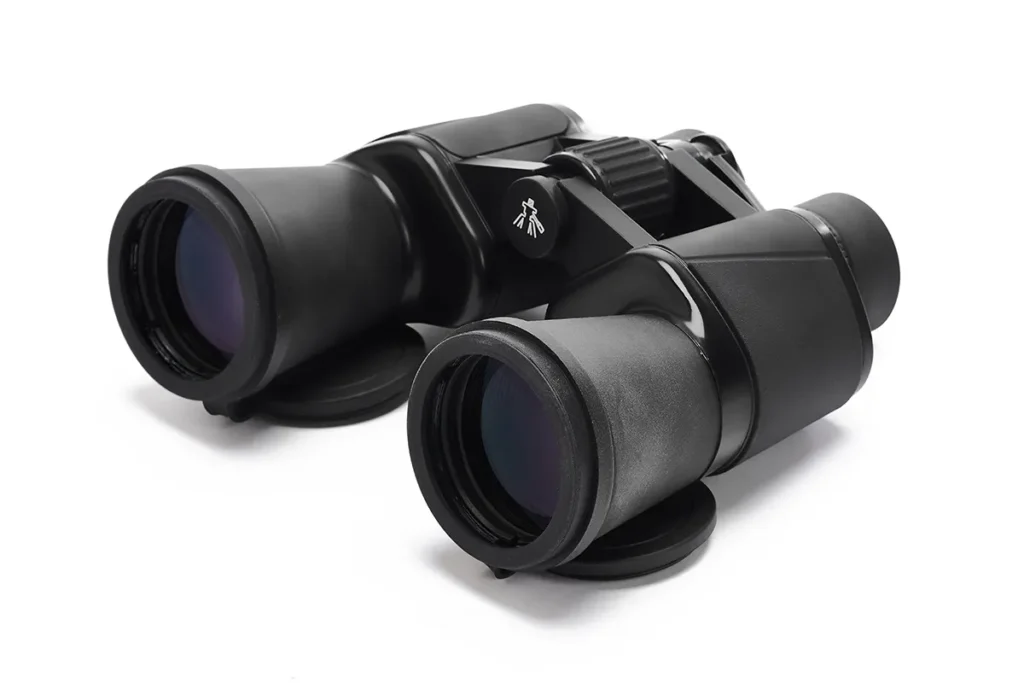
The Opticorn WA 10×50 is sturdy and well-performing. We tested them well and felt it was like making notes of what binocular reviews have been asking for in an entry-level pair of 10×50 for the years.
If you are looking for an expensive pair there, these binoculars are worth a look and are listed among the best binoculars for astronomy and stargazing for those on a budget.
Specs
| Optics | Fully multi-coated |
| Magnification | 10x |
| Aperture | 50mm |
| Prisms | Porro, BAK4 |
| Angular field of view | 6.5° |
| Focusing Centre focus, eye relief | 16mm |
| Interpupillary distance | 58–73 mm |
| Weight | 885g |
BEST FOR
- Tethered lens caps
- Fold-down rubber eyecups
- Smooth focusing
- Tripod-mountable
- Good right eyepiece dioptre range
PROS:
- Wide field astronomy
- Good light gathering
- Sharp images
- Robust construction
- Excellent value
- Clear view
- Smooth mechanics
- High-quality optics
CONS;
- Stiff focus wheel
- Clumsy ergonomics
- Slightly stiff central wheel
- Weight
Helios Stellar II 10×50 binoculars

The Helio Stellar II binocular comes with unique features like individual eyepiece focusing. This is a perfect choice for astronomy and stargazing. Meanwhile, you can set the focus and leave it alone.
They will tier your arm because it is much bulkier than other binoculars. However, our reviewer found that their mass also helps to reduce shake.
It produces impressive bright and excellent color rendition in images. The image is sharp over the central 80% of the 6.5° field of view. This makes it an excellent binocular for scanning the sky. It has several more features, including tethered lens caps for the eyepiece and the objective lenses. These caps are attached with binoculars. So they won’t get lost, and you may probably use them regularly. This binocular body is covered with rubbed rubber armour that protects it from everyday knocks. And provide a strong grip on binoculars.
Specs
| Build | Porro |
| Magnification | 7x |
| Minimum focusing distance | 5m |
| Objective lens diameter | 50mm |
| Dimensions | 192x202x66mm |
| Weight | 1.150kg |
BEST FOR
- Excellent color rendition
- Individual eyepiece focussing
- Ribbed rubber covering
- Tethered lens caps
PROS:
- Affordable
- Waterproof and Nitrogen-filled
- Tethered Lens Caps
- Good Eye Relief
CONS;
- Weight
- Field of View
- Focus Knob
Tips for Choosing the Right Binoculars
- Budget: Binoculars come in various prices, from affordable to high-end. Determine how much you will be comfortable to spend on binoculars. Higher-quality optics and features will naturally cost more.
- Ergonomics and weight: Choose binoculars that you feel comfortable to hold for extended periods. Think about the size and weight of the binoculars, especially if you plan on carrying them for long distances or using them for multiple hours at the same time. Look for binoculars that fit your eye sockets well and allow for easy focusing.
- Additional features: Some binoculars offer waterproofing, fogproofing, image stabilization, and varying degrees of eye relief. Consider which features are important for you. For example, waterproofing is crucial for outdoor activities that live near water or in wet environments, while image stabilization can be helpful for shaky hands or unsteady viewing conditions.
Conclusion
Binoculars are a great option for casual stargazing as compared to telescopes due to their portability and affordability. When choosing binoculars for stargazing, you must consider magnification, aperture, field of view, eye relief, and lens coating. Remember to consider your budget and desired features before making your final choice. What celestial objects are you most excited to see?
FAQS
Can I use any binoculars for astronomy?
Not all binoculars are suitable for stargazing. Look for binoculars with a magnification of 10x or higher, an aperture of at least 50mm, and fully multi-coated lenses for the best results.
What is the difference between porro prism and roof prism binoculars?
The main difference is in the way the internal prisms are arranged. Porro prism binoculars have an angled design, while roof prism binoculars have a straight-line design. This can affect factors such as image quality
Do I need to use a tripod with my binoculars for astronomy?
While it is not necessary to use a tripod, it can greatly improve your viewing experience. It will help stabilize the binoculars and reduce any shakiness from holding them by hand. If you plan on stargazing for extended periods or using higher magnification binoculars, then a tripod is recommended.
Can I use my binoculars during the day as well?
Yes, binoculars can be used for a variety of activities during the day, such as birdwatching, sports events, and even general sightseeing. Just make sure to adjust the focus for objects at different distances.
Are there any maintenance tips for keeping my binoculars in good condition?
To keep your binoculars in good working condition, make sure to clean them regularly with a soft cloth and store them in a protective case when not in use. Also, avoid touching the lenses directly with your fingers, as this can leave smudges or scratches. Additionally, it is important to protect them from extreme temperatures and moisture.

